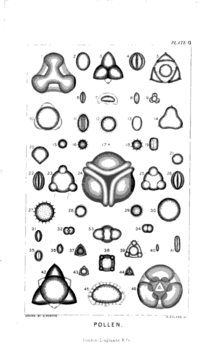Forensic palynology
Forensic palynology is the study of pollen, spores and other acid-resistant microscopic plant bodies, including dinoflagellates, to prove or disprove a relationship among objects, people and places that pertain to both criminal and civil cases.
| Part of a series on |
| Forensic science |
|---|
 |
|
Pollen can reveal where a person or object has been, because regions of the world, countries, and even different parts of a garden will have a distinctive pollen assemblage.[1] Pollen evidence can also reveal the season in which a particular object picked up the pollen.[2] Pollen has been used to trace activity at mass graves in Bosnia,[3] catch a burglar who brushed against a Hypericum bush during a crime,[4] and has been proposed as an additive for bullets to enable tracking them.[5]
As an example of use in investigation of homicides, a dead body may be found in a wood. The clothes may contain pollen that was released after death (the time of death can be determined by forensic entomology). If it is found to be from a place other than where the body was found, this indicates that the body was moved after death.
Palynology
Palynology is the study of pollen, spores, and other microscopic plant bodies such as dinoflagellates (marine algal cysts). Pollen carries the male gametes (sex cells) of flowering plants and plants that produce cones (e.g. spikey trees). Spores are asexual reproductive bodies of ferns, mosses and fungi.
Palynology is used by geologists to help date rocks for petroleum, mining, and water exploration and to help unravel the history of plants on Earth; by geographers to investigate climatic and environmental change: by botanists for plant taxonomy and phylogeny; by immunologist to investigate allergenic pollen; by archaeologists to study the customs, rituals and agricultural practices of ancient peoples; by zoologists and environmental scientists to understand foraging habits of insects, birds and mammals, and to investigate past native vegetation and habitats in order to preserve the present and protect endangered species.
Forensic palynology is used by police departments in criminal and civil investigations. For instance, this evidence may aid in identifying homicide victims and where they may have lived or been killed.
References
- Vaughn M. Bryant. "Forensic Palynology: A New Way to Catch Crooks". Archived from the original on 3 February 2007.
- Robert Stackhouse (17 April 2003), "Forensics studies look to pollen", The Battalion
- Peter Wood (9 September 2004), "Pollen helps war crime forensics", BBC News, retrieved 4 January 2010
- D. Mildenhall (2006), "Hypericum pollen determines the presence of burglars at the scene of a crime: An example of forensic palynology", Forensic Science International, 163 (3): 231–235, doi:10.1016/j.forsciint.2005.11.028, PMID 16406430
- "Newscripts", Chemical & Engineering News, 86, 33, 18 August 2008, p. 88